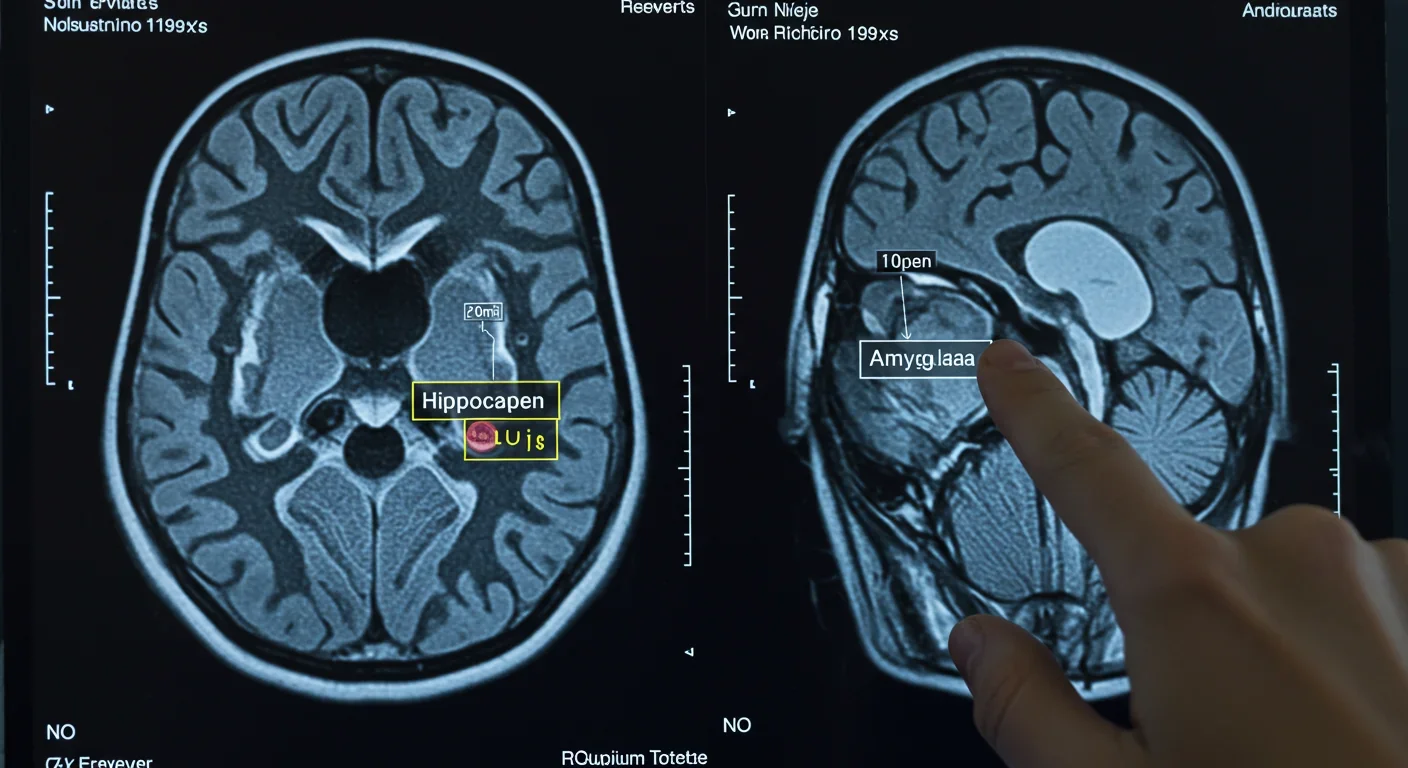Your Cell's Protein Cleanup Fails With Age—Causing Brain Disease

TL;DR: Loving-kindness meditation produces measurable brain changes in as little as eight weeks—increasing gray matter in empathy regions while reducing amygdala volume—and simultaneously lowers inflammatory markers like IL-6 and CRP by boosting vagal tone, making compassion practice a scientifically validated intervention with both neurological and immune system benefits.

What if cultivating kindness could physically reshape your brain while simultaneously calming the fires of chronic inflammation coursing through your body? Recent neuroscience research reveals that loving-kindness meditation (LKM)—a practice where you silently repeat phrases of goodwill toward yourself and others—produces measurable changes in deep brain structures and triggers biological transformations that lower key inflammatory markers. This isn't mysticism meeting medicine. It's hard science demonstrating that compassion meditation creates real, observable alterations in both neural pathways and immune function, making the ancient practice a validated intervention with modern therapeutic potential.
Researchers at Mount Sinai broke new ground by recording neural activity directly from deep within the brain during meditation. Using invasive electrodes implanted in eight epilepsy patients, they captured real-time changes in the amygdala and hippocampus—regions governing emotion and memory—during a 10-minute loving-kindness meditation session. Even first-time meditators showed immediate shifts in beta and gamma brain waves, electrical signatures known to be disrupted in depression and anxiety.
"We found that loving kindness meditation is associated with changes in the strength and duration of certain types of brain waves."
— Dr. Ignacio Saez, Lead Author, Mount Sinai Study
The participants, all self-reported meditation novices, achieved an average meditation depth of 7.43 out of 10—proof that you don't need years of practice to trigger these neural shifts.
But acute changes are just the beginning. Structural brain imaging reveals that consistent practice over eight weeks produces measurable increases in gray matter density in key regions: the hippocampus (memory formation), the anterior cingulate cortex (attention and emotional regulation), and the insula (interoceptive awareness and empathy). Meanwhile, gray matter volume in the amygdala—your brain's alarm system—actually decreases, suggesting reduced reactivity to stress.
Dr. Britta Hölzel, whose research documented these structural changes, put it simply: "It is fascinating to see the brain's plasticity and that, by practicing meditation, we can play an active role in changing the brain and can increase our well-being and quality of life."
Meditation has existed for millennia, but only recently have neuroimaging tools allowed scientists to peer inside the meditating brain. The turning point came in the early 2000s when researchers like Richard Davidson and Sara Lazar began using functional MRI to track blood flow and structural MRI to measure gray matter changes in long-term meditators.
Early studies focused on mindfulness meditation—observing thoughts without judgment. But loving-kindness meditation presented something different: an active cultivation of positive emotions toward oneself and others. Instead of detached observation, LKM practitioners mentally rehearse phrases like "May I be happy, may I be healthy, may I be safe" before extending those wishes to loved ones, neutral people, difficult individuals, and finally all beings.
This intentional generation of compassion appeared to activate distinct neural circuits. A Stanford University study found that just weeks of loving-kindness practice increased activity in brain regions associated with empathy and caregiving—the insula and anterior cingulate cortex—and made participants measurably more willing to help strangers in need.

Research comparing expert meditators to novices revealed something striking: expert LKM practitioners showed unique neural responses when viewing happy faces, suggesting their brains had learned to share others' positive emotions more deeply. One study put it beautifully: the experts could "feel their happiness as their own."
Here's where neuroscience meets immunology. Chronic low-grade inflammation—marked by elevated levels of C-reactive protein (CRP), interleukin-6 (IL-6), and tumor necrosis factor-alpha (TNF-α)—underlies conditions from cardiovascular disease to diabetes to depression. For decades, inflammation was viewed as purely physical. Then researchers discovered the vagus nerve acts as a communication highway between brain and body, carrying signals that directly modulate immune function.
The vagus nerve is your body's chief regulator of the parasympathetic nervous system—the "rest and digest" mode that counteracts fight-or-flight stress responses.
When vagal tone (the strength of vagus nerve activity) increases, heart rate slows, blood pressure drops, digestion improves, and critically, inflammatory signaling pathways quiet down.
Studies on loving-kindness meditation consistently show increased vagal tone among practitioners. Dr. Arielle Schwartz explains: "An increase in vagal tone is linked to a reduction in inflammation and better prognosis in people suffering from chronic illness, anxiety, or depression."
The mechanistic pathway goes like this: compassion meditation activates the ventral vagal complex, which regulates social engagement and feelings of safety. This vagal activation triggers what scientists call the "cholinergic anti-inflammatory pathway"—vagus nerve signals release acetylcholine, which inhibits the production of pro-inflammatory cytokines. The result? Measurable reductions in CRP, IL-6, and TNF-α in regular meditators.
One of the most practical questions for anyone considering meditation is simple: how much practice produces results?
The data converges on a surprisingly modest threshold. Studies using eight-week programs with participants practicing 27 minutes daily showed structural brain changes visible on MRI. But you don't need to wait two months for benefits. The Mount Sinai intracranial recordings showed neural activity shifts during a single 10-minute session, and behavioral changes—increased willingness to help others, greater emotional sharing—appeared after just a few weeks of consistent practice.
For pain management, research on chronic low back pain patients found a dose-response relationship: patients who practiced most experienced the greatest reductions in pain and anger the following day. The message is clear—more practice brings more benefit, but even modest, consistent engagement produces measurable effects.

Long-term practitioners show the most dramatic structural changes. One study examining meditators with 5 to 46 years of practice (averaging 24 years) found significantly larger volumes in the hippocampus, orbitofrontal cortex, thalamus, and inferior temporal gyrus—all emotion-regulating regions—compared to non-meditators. These aren't subtle differences; they're robust structural adaptations reflecting decades of mental training.
"We know that people who consistently meditate have a singular ability to cultivate positive emotions, retain emotional stability and engage in mindful behavior."
— Dr. Eileen Luders, Neuroscientist
The brain imaging provided the anatomical explanation for those abilities.
Not all meditation is created equal, and understanding the distinctions helps clarify what loving-kindness practice uniquely offers.
Mindfulness meditation trains attention on present-moment experience—breath, body sensations, thoughts—without trying to change anything. It cultivates equanimity and reduces rumination. Brain imaging shows mindfulness increases gray matter in attention-regulating regions and the hippocampus while decreasing amygdala volume.
Loving-kindness meditation actively generates positive emotions and directs compassionate wishes toward oneself and others. While it shares some neural effects with mindfulness (both engage the anterior cingulate and insula), LKM shows stronger activation in empathy-related circuits and produces greater increases in positive affect. One systematic review found that compassion-based meditations specifically increase activation in brain areas involved in emotional processing and empathy.
The practical implication? Mindfulness excels at stress reduction and emotional regulation through detachment. Loving-kindness appears uniquely positioned for conditions where cultivating connection and positive emotion matters—depression, social anxiety, chronic pain with an emotional component, and yes, inflammation-related conditions where the vagal pathway offers therapeutic leverage.
Interestingly, researchers found no change in insular gray matter after eight weeks of mindfulness practice, suggesting this region may require longer practice or respond better to compassion-focused approaches. Since the insula plays a crucial role in empathy and interoceptive awareness, this finding hints at LKM's potential advantage for social-emotional outcomes.
Understanding how meditation rewires the brain reveals why the effects persist beyond practice sessions.
Neuroplasticity—the brain's ability to reorganize itself by forming new neural connections—operates on a simple principle: neurons that fire together wire together. When you repeatedly activate specific brain regions through mental training, those regions physically change. Synaptic connections strengthen, dendrites branch, and in some cases, entirely new neurons form through neurogenesis.
Each time you generate feelings of warmth toward yourself or others during meditation, you're running neural drills that strengthen empathy circuits and emotional regulation pathways.

During loving-kindness meditation, you're essentially running neural drills. Each time you generate feelings of warmth toward yourself or others, you activate the anterior cingulate cortex (regulating attention and emotion), the insula (processing empathy and bodily states), and the prefrontal cortex (executive control). Do this daily for weeks, and those regions develop increased gray matter density—more neurons, more synaptic connections, more processing capacity.
The amygdala tells the opposite story. This almond-shaped structure triggers fear and stress responses. Meditation appears to reduce its gray matter volume, essentially down-regulating threat reactivity. Less reactive amygdala means lower stress hormones, including cortisol, which itself drives inflammatory processes.
The hippocampus benefits too. Critical for memory formation and emotional context, hippocampal volume increases with meditation practice, potentially explaining improved emotional regulation. You're literally building more capacity to contextualize experiences rather than react reflexively.
The most remarkable aspect of compassion meditation may be how neural changes translate into immune function changes—a perfect demonstration of the mind-body connection.
When the anterior cingulate and insula activate during loving-kindness practice, they don't operate in isolation. These regions send signals through the autonomic nervous system, particularly the vagus nerve, which innervates virtually every organ. Increased vagal tone shifts the body from sympathetic (stress) to parasympathetic (rest) dominance.
This autonomic shift has immediate downstream effects. The vagus nerve releases acetylcholine at immune system sites, binding to receptors on macrophages and other immune cells. This binding inhibits the NF-κB signaling pathway, a master regulator of inflammatory gene expression. Result: less production of IL-6, TNF-α, and other pro-inflammatory cytokines.
Studies measuring these biomarkers before and after meditation interventions show consistent reductions in CRP and IL-6, the same inflammatory markers cardiologists monitor for heart disease risk. One analysis noted that regular meditation produces reductions in pro-inflammatory signaling pathways and lower CRP levels—a protein strongly associated with systemic inflammation.
The cardiovascular implications are significant. Research on long-term meditators revealed improved nitric oxide metabolism and lower reported stress. Nitric oxide dilates blood vessels, improves blood flow, and protects against atherosclerosis. The connection runs: meditation → vagal tone → nitric oxide production → vascular health.
The beauty of loving-kindness meditation is its accessibility. You don't need equipment, special settings, or years of training to begin reaping benefits.
A basic session follows this structure:
Settle yourself (2 minutes): Sit comfortably, close your eyes, take several deep breaths to center your attention.
Start with yourself (3-5 minutes): Silently repeat phrases like "May I be safe. May I be healthy. May I be happy. May I live with ease." Feel the intention behind the words rather than just reciting mechanically.
Expand to loved ones (3-5 minutes): Bring to mind someone you care about deeply. Direct the same phrases toward them: "May you be safe. May you be healthy."

Include neutral people (2-3 minutes): Picture someone you see regularly but don't know well—a cashier, neighbor, coworker. Extend the same wishes.
Approach difficult people (2-3 minutes): This is advanced but powerful. Think of someone you have conflict with and try (even if it feels forced) to wish them well.
Extend to all beings (2-3 minutes): Open your awareness to all living things and offer universal goodwill.
Start with 10-15 minutes daily. Based on the research showing effects with 27 minutes daily practice, you might gradually extend sessions as the practice feels more natural. Consistency matters more than duration—daily short sessions beat occasional long ones.
Many people find guided audio helpful initially. Apps like Insight Timer offer hundreds of free LKM sessions. The Mount Sinai study used audio guidance, so you're following research-validated protocols.
While loving-kindness meditation offers broad benefits, certain populations may find it particularly valuable:
Chronic pain patients: The study on low back pain showed that compassion practice reduced both pain intensity and anger—addressing physical and emotional dimensions simultaneously.
People with inflammatory conditions: If you're managing autoimmune disease, cardiovascular issues, or metabolic syndrome, the anti-inflammatory effects via vagal tone offer a complementary approach alongside medical treatment.
Those with mood disorders: Depression and anxiety involve both altered brain activity in emotion-regulating regions and elevated inflammatory markers. LKM addresses both, potentially explaining why it shows promise in mental health contexts.
Healthcare workers and caregivers: Professions involving high empathic demand benefit from practices that enhance empathy circuits while simultaneously reducing burnout through stress reduction.
Anyone experiencing social disconnection: The practice explicitly builds neural circuits for social connection and appears to increase prosocial behavior in real-world situations.
Despite robust findings, important caveats remain. Many studies involve small sample sizes. The Mount Sinai invasive recording study included just eight participants, though the direct neural measurement provided unprecedented resolution. Larger randomized controlled trials would strengthen causal claims.
Most research compares meditators to non-meditators, raising selection bias concerns—perhaps people drawn to meditation differ in other health behaviors. More studies with active control groups (listening to audiobooks, for example) would help isolate meditation-specific effects.
The optimal meditation "dose" remains unclear—would 15 minutes daily work as well as 27? Do benefits plateau or continue increasing with years of practice?
Individual variation likely matters. Some people naturally generate stronger responses to meditation, just as some respond better to particular medications. Identifying predictors of response would help target the intervention where it offers most benefit.
Finally, most research focuses on Western, educated populations. Cross-cultural studies would reveal whether effects generalize across different contexts and meditation traditions.
Neuroscience has validated what contemplative traditions taught for centuries: cultivating compassion changes the mind. But now we understand the specific mechanisms—beta and gamma wave modulation in the amygdala, gray matter increases in empathy circuits, vagal activation triggering anti-inflammatory pathways.
This mechanistic understanding opens new therapeutic possibilities. Could loving-kindness meditation be prescribed alongside statins for cardiovascular disease? Might it augment treatment for autoimmune conditions? Can it prevent the chronic low-grade inflammation that accelerates aging?
Researchers are exploring these questions. Clinical trials are testing LKM for PTSD, chronic pain, and inflammatory bowel disease. Neuroscientists are using increasingly sophisticated imaging to map exactly which neural circuits change with practice. Immunologists are measuring inflammatory markers with greater precision to understand dose-response relationships.
The synthesis of ancient practice and modern science also raises philosophical questions. If we can deliberately reshape our brains and immune systems through mental training, what does that mean for how we approach health? It challenges the strict dualism separating mind and body, revealing instead a deeply integrated system where thoughts, emotions, and physiology continuously interact.
The evidence suggests that loving-kindness meditation offers something rare: a simple, accessible practice with measurable neurological and physiological benefits. You don't need to commit to becoming a meditation adept. The research shows that even novice practitioners experience neural changes during their first sessions, and consistent practice over weeks produces structural brain adaptations and reduces inflammatory markers.
Perhaps most importantly, the practice aligns internal experience with external measurement. When participants report feeling more connected, more compassionate, more emotionally stable, brain scans show corresponding changes in empathy circuits. When they describe feeling calmer and less reactive, inflammatory markers confirm the biological shift.
This convergence of subjective experience and objective biomarkers suggests we're glimpsing something fundamental about human neurobiology: the capacity for self-directed change. By choosing to cultivate compassion, you're not just feeling different—you're physically rewiring neural pathways and modulating immune function.
The next time you sit down, close your eyes, and repeat "May I be happy, may I be healthy," remember you're participating in a practice that ancient contemplatives developed through introspection and that modern neuroscience has now validated through MRI scans, inflammatory markers, and intracranial recordings. You're engaging in something simultaneously ancient and cutting-edge: the systematic cultivation of compassion, with measurable effects that ripple from neurons to cytokines, from brain structure to immune function, from individual well-being to the way you engage with the world.

Curiosity rover detects mysterious methane spikes on Mars that vanish within hours, defying atmospheric models. Scientists debate whether the source is hidden microbial life or geological processes, while new research reveals UV-activated dust rapidly destroys the gas.

CMA is a selective cellular cleanup system that targets damaged proteins for degradation. As we age, CMA declines—leading to toxic protein accumulation and neurodegeneration. Scientists are developing therapies to restore CMA function and potentially prevent brain diseases.

Intercropping boosts farm yields by 20-50% by growing multiple crops together, using complementary resource use, nitrogen fixation, and pest suppression to build resilience against climate shocks while reducing costs.

The Baader-Meinhof phenomenon explains why newly learned information suddenly seems everywhere. This frequency illusion results from selective attention and confirmation bias—adaptive evolutionary mechanisms now amplified by social media algorithms.

Plants and soil microbes form powerful partnerships that can clean contaminated soil at a fraction of traditional costs. These phytoremediation networks use biological processes to extract, degrade, or stabilize toxic pollutants, offering a sustainable alternative to excavation for brownfields and agricultural land.

Renters pay mortgage-equivalent amounts but build zero wealth, creating a 40x wealth gap with homeowners. Institutional investors have transformed housing into a wealth extraction mechanism where working families transfer $720,000+ over 30 years while property owners accumulate equity and generational wealth.

AlphaGo revolutionized AI by defeating world champion Lee Sedol through reinforcement learning and neural networks. Its successor, AlphaGo Zero, learned purely through self-play, discovering strategies superior to millennia of human knowledge—opening new frontiers in AI applications across healthcare, robotics, and optimization.